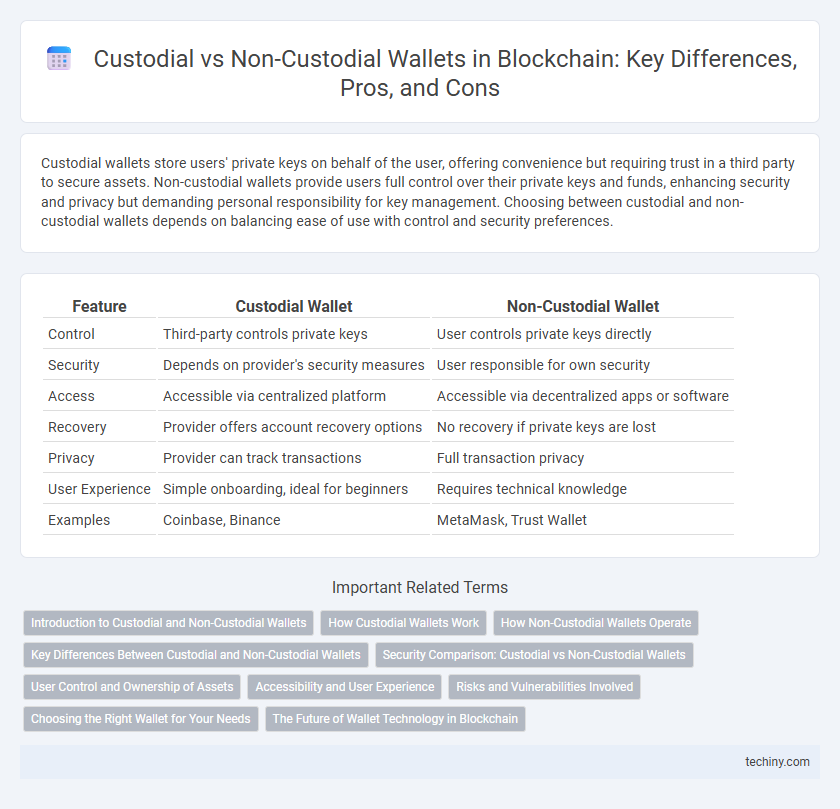Custodial wallets store users' private keys on behalf of the user, offering convenience but requiring trust in a third party to secure assets. Non-custodial wallets provide users full control over their private keys and funds, enhancing security and privacy but demanding personal responsibility for key management. Choosing between custodial and non-custodial wallets depends on balancing ease of use with control and security preferences.
Table of Comparison
| Feature | Custodial Wallet | Non-Custodial Wallet |
|---|---|---|
| Control | Third-party controls private keys | User controls private keys directly |
| Security | Depends on provider's security measures | User responsible for own security |
| Access | Accessible via centralized platform | Accessible via decentralized apps or software |
| Recovery | Provider offers account recovery options | No recovery if private keys are lost |
| Privacy | Provider can track transactions | Full transaction privacy |
| User Experience | Simple onboarding, ideal for beginners | Requires technical knowledge |
| Examples | Coinbase, Binance | MetaMask, Trust Wallet |
Introduction to Custodial and Non-Custodial Wallets
Custodial wallets store private keys on behalf of users, offering ease of access and customer support but requiring trust in a third party, which introduces counterparty risk. Non-custodial wallets give users full control over their private keys and funds, enhancing security and privacy while placing the responsibility of key management solely on the user. These fundamental differences shape how users interact with blockchain assets and influence security, usability, and control preferences.
How Custodial Wallets Work
Custodial wallets operate by entrusting a third-party service provider with the management and security of users' private keys, enabling easier access and recovery options. These wallets facilitate user transactions through centralized platforms that handle authentication, key storage, and backup, reducing the complexity of self-management. While offering convenience and support, custodial wallets require users to rely on the provider's security measures and policies to protect digital assets.
How Non-Custodial Wallets Operate
Non-custodial wallets operate by granting users full control over their private keys, enabling direct access to their cryptocurrency assets without relying on third-party intermediaries. These wallets use encryption methods and decentralized key storage to ensure that only the wallet holder can authorize transactions and manage funds. By maintaining private keys locally on devices or through secure seed phrases, non-custodial wallets enhance security and privacy while empowering users with complete ownership of their digital assets.
Key Differences Between Custodial and Non-Custodial Wallets
Custodial wallets store private keys on behalf of users, offering convenience but relying on third-party security measures, while non-custodial wallets give users full control over their private keys, enhancing security and privacy. Custodial wallets often provide easier recovery options and user-friendly interfaces, whereas non-custodial wallets require users to manage backups and protect their keys independently. The trade-off between convenience and control defines the key differences, impacting user responsibility and risk exposure in blockchain asset management.
Security Comparison: Custodial vs Non-Custodial Wallets
Custodial wallets store private keys on behalf of users, creating a single point of failure that can be vulnerable to hacks or insider threats, while offering convenience and recovery options. Non-custodial wallets grant users full control over their private keys, significantly reducing the risk of centralized breaches but placing complete responsibility on users for backup and security. Security in non-custodial wallets depends heavily on users' ability to safely manage their keys, whereas custodial wallets rely on the provider's security protocols and infrastructure.
User Control and Ownership of Assets
Custodial wallets store private keys on behalf of users, granting limited control over assets and relying on third-party security protocols. Non-custodial wallets provide users with full ownership and direct control of their private keys, enhancing security and autonomy in managing digital assets. User responsibility for key management and backup is critical in non-custodial wallets to prevent loss of access.
Accessibility and User Experience
Custodial wallets provide greater accessibility by handling private keys on behalf of users, simplifying the experience for beginners and enabling easy recovery options. Non-custodial wallets offer enhanced control and security, requiring users to manage their private keys directly, which can be less user-friendly but critical for privacy. The user experience varies significantly, with custodial wallets prioritizing convenience and non-custodial wallets emphasizing autonomy.
Risks and Vulnerabilities Involved
Custodial wallets expose users to risks such as centralized control, making funds vulnerable to hacking, insider threats, and platform insolvency. Non-custodial wallets reduce third-party risk by giving users sole control of private keys but increase vulnerability to user errors like lost keys or inadequate security practices. Both wallet types require careful consideration of threat models, as custodial solutions depend on service provider security, while non-custodial wallets demand rigorous personal security management.
Choosing the Right Wallet for Your Needs
Choosing the right wallet depends on your priority between control and convenience; custodial wallets offer ease of use by managing private keys for you, while non-custodial wallets provide full ownership and security by giving you sole control over your keys. Custodial wallets are ideal for beginners or those who prefer trusting a third party, whereas non-custodial wallets suit experienced users prioritizing privacy and decentralization. Assess your risk tolerance, technical knowledge, and the importance of self-sovereignty to select the wallet that best aligns with your blockchain asset management needs.
The Future of Wallet Technology in Blockchain
Custodial wallets, managed by third-party services, offer ease of use and recovery options but pose risks related to centralization and security breaches. Non-custodial wallets provide users with full control over private keys, enhancing security and privacy but requiring greater responsibility in key management. The future of wallet technology in blockchain leans towards hybrid solutions combining user control with seamless recovery, leveraging advancements in multi-signature schemes and decentralized identity protocols.
Custodial wallet vs Non-custodial wallet Infographic

 techiny.com
techiny.com